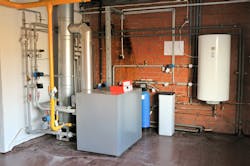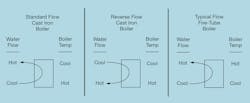We were at one of the Catholic compounds not too far from the office. Besides the Kid and I, his boss was along to look at some air conditioning opportunities. We met the contractor, found the custodian and all went down to the boiler room. Full disclosure, I was raised and schooled at a compound, although a small one by Cincinnati standards.
When I say compound, I mean there is a church, a couple of school buildings, a rectory, and a convent. This whole operation takes up more than a city block. The boiler we came to look at heats the couple of school buildings. Just like other parishes, there was a sudden surge of kids to educate in the ‘50s and ‘60s, so new buildings were built or existing buildings got an addition.
This one looked to be from the sixties. It was a high mass, cast iron sectional hot water boiler, which is very typical for the era and application. From the twenties to the fifties, steam systems were the norm for institutional buildings. Around the mid-century mark, the tide turned to hot water, the modern way to heat.
For you oil guys, Cincinnati has always been a gas town. Oil was for the outskirts, and one rich neighborhood that held out until the seventies. So, this boiler was the atmospheric draft style, a few tons of cast iron sections sitting on a base with ribbon burners burning natural gas.
Pumps Tell No Lies
The flue gasses warm the cast iron sections as they travel up, along their path to the giant chimney, formerly used for a coal boiler. The cooler water from the return of the system usually enters the boiler at the bottom, where the flames are and the temperature is the hottest. That’s what I was expecting.
One of the first things I do at a job site visit is determine the direction of flow in the pipes I can see. Sometimes you don’t see too much, but this boiler room wasn’t keeping any secrets. I saw the typical pipes on the boiler, one on the bottom and one towards the top, on opposite sides. Nothing out of the ordinary so far.
There were a couple of pumps on the pipe going to the bottom, while straight pipe left from the top. Pumps tell no lies, when it comes to directional flow—at least the single phase motor pumps. These couple of pumps were single phase in-line style, with a directional arrow clearly marked on each. Three phase pumps can go backwards if not phased correctly.
Going Which Way Now?
Usually when you find the pumps on the pipe leading to the bottom of a cast iron atmospheric boiler, the flow is towards the boiler. However, here the flow was leading away from the boiler. How strange to have the flow going in the opposite direction through the boiler. Definitely wasn’t piped according to the boiler manufacturer.
I pointed this out to the Kid and his boss. I wanted the Kid to see a job like this and wanted his boss to be impressed with my knowledge of boiler systems. We’ve been working in the same office for the past ten years or so and he has been keeping a journal of some of my observations/rules of life (like, “buy a house with a flat driveway.”) I thought he might like this one, “never assume the flow in a system.”
I remembered that long ago, when I was reading up on the available literature of the boiler manufacturer we were selling, there was an engineering bulletin about reverse flow in hot water boilers. I don’t remember much about it, just that it was a semi-popular idea in the 1960’s. I have only seen it once before in the field and never in any manufacturer’s installation instructions, so it must not have been a very good idea. Usually the good ones stick around.
Old Boilers and New
It got me thinking about the flow in the high efficiency boilers we were going to be quoting on this replacement job. They are the fire-tube heat exchanger design, with the burner on the top and the flue gases going down through the boiler, pushed by the modulating inducer fan. This is opposite of the typical cast iron boiler, where the burner is at the bottom and the flue gases naturally rise up through the boiler.
The old design of the gas atmospheric was adapted from the older design of a coal fired boiler and gravity circulation of the water. The cooler water had to return to the bottom to be warmed up and leave at the top as hotter water. Both had the cooler water from the system entering the boiler where it is hottest.
The not-so-popular-at-the-time idea of reverse flow was just the opposite. The cooler water entered the boiler where the boiler was the coolest, and left the boiler where it was the hottest. The modern fire-tube boilers now use the same concept. The cooler return water enters at the bottom of the boiler where the flue gasses are the coolest and the warmer supply water leaves at the top of the boiler where the burner is located and the temperature is the hottest.
“What once was old is new again,” the Kid’s boss has a new truism for his journal.
Final Note
I would like to note the passing of a fellow Air Force and boiler trade veteran, Dale Schweitzer. Dale was Viet Nam era, spending too much time on Johnston Atoll in the Pacific Ocean with Agent Orange. The cancer took him too early. War has many side effects. God’s speed Airman.
Patrick Linhardt is a thirty-nine-year veteran of the wholesale side of the hydronic industry who has been designing and troubleshooting steam and hot water heating systems, pumps and controls on an almost daily basis. An educator and author, he is currently Hydronic Manager at the Corken Steel Products Co.
About the Author
Patrick Linhardt
Patrick Linhardt is a forty-one-year veteran of the wholesale side of the hydronic industry who has been designing and troubleshooting steam and hot water heating systems, pumps and controls on an almost daily basis. An educator and author, he is currently Hydronic Manager at the Corken Steel Products Co.

